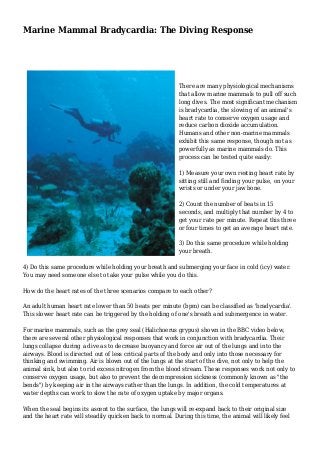
Marine Mammal Bradycardia: The Diving Response
- 1. Marine Mammal Bradycardia: The Diving Response There are many physiological mechanisms that allow marine mammals to pull off such long dives. The most significant mechanism is bradycardia, the slowing of an animal's heart rate to conserve oxygen usage and reduce carbon dioxide accumulation. Humans and other non-marine mammals exhibit this same response, though not as powerfully as marine mammals do. This process can be tested quite easily: 1) Measure your own resting heart rate by sitting still and finding your pulse, on your wrists or under your jaw bone. 2) Count the number of beats in 15 seconds, and multiply that number by 4 to get your rate per minute. Repeat this three or four times to get an average heart rate. 3) Do this same procedure while holding your breath. 4) Do this same procedure while holding your breath and submerging your face in cold (icy) water. You may need someone else to take your pulse while you do this. How do the heart rates of the three scenarios compare to each other? An adult human heart rate lower than 50 beats per minute (bpm) can be classified as 'bradycardia'. This slower heart rate can be triggered by the holding of one's breath and submergence in water. For marine mammals, such as the grey seal (Halichoerus grypus) shown in the BBC video below, there are several other physiological responses that work in conjunction with bradycardia. Their lungs collapse during a dive as to decrease buoyancy and force air out of the lungs and into the airways. Blood is directed out of less critical parts of the body and only into those necessary for thinking and swimming. Air is blown out of the lungs at the start of the dive, not only to help the animal sink, but also to rid excess nitrogen from the blood stream. These responses work not only to conserve oxygen usage, but also to prevent the decompression sickness (commonly known as "the bends") by keeping air in the airways rather than the lungs. In addition, the cold temperatures at water depths can work to slow the rate of oxygen uptake by major organs. When the seal begins its ascent to the surface, the lungs will re-expand back to their original size and the heart rate will steadily quicken back to normal. During this time, the animal will likely feel
- 2. rapid warmth return to his or her extremities, allowing for a faster muscular response. It has been observed that younger marine mammals do not exhibit as strong of a bradycardia response as older members of the same species. This is measured in the heart rate itself, as a lower heart rate during a dive indicates a stronger bradycardia. With maturity also comes a higher concentration of myoglobin, an oxygen-bonding protein in the muscle tissue of vertebrates. Myoglobin exists in high concentration particularly in marine mammals, with a direct correlation to diving depth of certain mammals. By regulating both the amount and distribution of vital oxygen during a dive, the bradycardia response allows for many marine mammals to achieve deeper dives, and with it a greater variety of food sources. This is one of many remarkable evolutionary mechanisms for life in the water that marine mammals exhibit. http://mermikell.hubpages.com/hub/Marine-Mammal-Bradycardia-The-Diving-Response